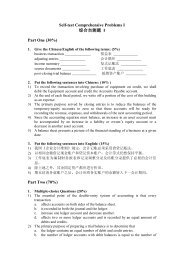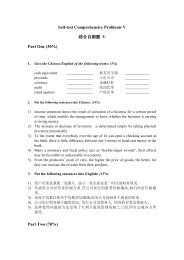Vodafone Group Plc Annual Report for the year ended 31 March 2012
Vodafone Group Plc Annual Report for the year ended 31 March 2012
Vodafone Group Plc Annual Report for the year ended 31 March 2012
You also want an ePaper? Increase the reach of your titles
YUMPU automatically turns print PDFs into web optimized ePapers that Google loves.
<strong>Vodafone</strong> <strong>Group</strong> <strong>Plc</strong><br />
<strong>Annual</strong> <strong>Report</strong> <strong>2012</strong> 144<br />
Notes to <strong>the</strong> Company financial statements<br />
1. Basis of preparation<br />
The separate financial statements of <strong>the</strong> Company are drawn up in<br />
accordance with <strong>the</strong> Companies Act 2006 and UK GAAP.<br />
The preparation of Company financial statements in con<strong>for</strong>mity with<br />
generally accepted accounting principles requires management to<br />
make estimates and assumptions that affect <strong>the</strong> reported amounts of<br />
assets and liabilities and disclosure of contingent assets and liabilities<br />
at <strong>the</strong> date of <strong>the</strong> Company financial statements and <strong>the</strong> reported<br />
amounts of revenue and expenses during <strong>the</strong> reporting period. Actual<br />
results could differ from those estimates. The estimates and underlying<br />
assumptions are reviewed on an ongoing basis. Revisions to accounting<br />
estimates are recognised in <strong>the</strong> period in which <strong>the</strong> estimate is revised if<br />
<strong>the</strong> revision affects only that period or in <strong>the</strong> period of <strong>the</strong> revision and<br />
future periods if <strong>the</strong> revision affects both current and future periods.<br />
As permitted by section 408(3) of <strong>the</strong> Companies Act 2006, <strong>the</strong> profit<br />
and loss account of <strong>the</strong> Company is not presented in this annual report.<br />
These separate financial statements are not int<strong>ended</strong> to give a true and<br />
fair view of <strong>the</strong> profit or loss or cash flows of <strong>the</strong> Company. The Company<br />
has not published its individual cash flow statement as its liquidity,<br />
solvency and financial adaptability are dependent on <strong>the</strong> <strong>Group</strong> ra<strong>the</strong>r<br />
than its own cash flows.<br />
The Company has taken advantage of <strong>the</strong> exemption contained in FRS 8<br />
“Related Party Disclosures” and has not reported transactions with<br />
fellow <strong>Group</strong> undertakings.<br />
The Company has taken advantage of <strong>the</strong> exemption contained in<br />
FRS 29 “Financial Instruments: Disclosures” and has not produced any<br />
disclosures required by that standard, as disclosures that comply with<br />
FRS 29 are available in <strong>the</strong> <strong>Vodafone</strong> <strong>Group</strong> <strong>Plc</strong> annual report <strong>for</strong> <strong>the</strong><br />
<strong>year</strong> <strong>ended</strong> <strong>31</strong> <strong>March</strong> <strong>2012</strong>.<br />
2. Significant accounting policies<br />
The Company’s significant accounting policies are described below.<br />
Accounting convention<br />
The Company financial statements are prepared under <strong>the</strong> historical<br />
cost convention and in accordance with applicable accounting<br />
standards of <strong>the</strong> UK Accounting Standards Board and pronouncements<br />
of <strong>the</strong> Urgent Issues Task Force.<br />
Investments<br />
Shares in <strong>Group</strong> undertakings are stated at cost less any provision<br />
<strong>for</strong> impairment.<br />
The Company assesses investments <strong>for</strong> impairment whenever events<br />
or changes in circumstances indicate that <strong>the</strong> carrying value of an<br />
investment may not be recoverable. If any such indication of impairment<br />
exists, <strong>the</strong> Company makes an estimate of <strong>the</strong> recoverable amount.<br />
If <strong>the</strong> recoverable amount of <strong>the</strong> cash-generating unit is less than <strong>the</strong><br />
value of <strong>the</strong> investment, <strong>the</strong> investment is considered to be impaired<br />
and is written down to its recoverable amount. An impairment loss is<br />
recognised immediately in <strong>the</strong> profit and loss account.<br />
For available-<strong>for</strong>-sale investments, gains and losses arising from changes<br />
in fair value are recognised directly in equity, until <strong>the</strong> investment<br />
is disposed of or is determined to be impaired, at which time <strong>the</strong><br />
cumulative gain or loss previously recognised in equity, determined<br />
using <strong>the</strong> weighted average cost method, is included in <strong>the</strong> net profit or<br />
loss <strong>for</strong> <strong>the</strong> period.<br />
Foreign currencies<br />
Transactions in <strong>for</strong>eign currencies are initially recorded at <strong>the</strong> rates<br />
of exchange prevailing on <strong>the</strong> dates of <strong>the</strong> transactions. Monetary<br />
assets and liabilities denominated in <strong>for</strong>eign currencies are<br />
retranslated into <strong>the</strong> Company’s functional currency at <strong>the</strong> rates<br />
prevailing on <strong>the</strong> balance sheet date. Non-monetary items carried at<br />
fair value that are denominated in <strong>for</strong>eign currencies are retranslated<br />
at <strong>the</strong> rates prevailing on <strong>the</strong> initial transaction dates. Non-monetary<br />
items measured in terms of historical cost in a <strong>for</strong>eign currency are<br />
not retranslated.<br />
Exchange differences arising on <strong>the</strong> settlement of monetary items,<br />
and on <strong>the</strong> retranslation of monetary items, are included in <strong>the</strong> profit<br />
and loss account <strong>for</strong> <strong>the</strong> period. Exchange differences arising on <strong>the</strong><br />
retranslation of non-monetary items carried at fair value are included<br />
in <strong>the</strong> profit and loss account <strong>for</strong> <strong>the</strong> period.<br />
Borrowing costs<br />
All borrowing costs are recognised in <strong>the</strong> profit and loss account in <strong>the</strong><br />
period in which <strong>the</strong>y are incurred.<br />
Taxation<br />
Current tax, including UK corporation tax and <strong>for</strong>eign tax, is provided<br />
at amounts expected to be paid (or recovered) using <strong>the</strong> tax rates and<br />
laws that have been enacted or substantively enacted by <strong>the</strong> balance<br />
sheet date.<br />
Deferred tax is provided in full on timing differences that exist at <strong>the</strong><br />
balance sheet date and that result in an obligation to pay more tax, or<br />
a right to pay less tax in <strong>the</strong> future. The deferred tax is measured at <strong>the</strong><br />
rate expected to apply in <strong>the</strong> periods in which <strong>the</strong> timing differences are<br />
expected to reverse, based on <strong>the</strong> tax rates and laws that are enacted<br />
or substantively enacted at <strong>the</strong> balance sheet date. Timing differences<br />
arise from <strong>the</strong> inclusion of items of income and expenditure in taxation<br />
computations in periods different from those in which <strong>the</strong>y are included<br />
in <strong>the</strong> Company financial statements. Deferred tax assets are recognised<br />
to <strong>the</strong> extent that it is regarded as more likely than not that <strong>the</strong>y will be<br />
recovered. Deferred tax assets and liabilities are not discounted.<br />
Financial instruments<br />
Financial assets and financial liabilities, in respect of financial<br />
instruments, are recognised on <strong>the</strong> Company balance sheet when<br />
<strong>the</strong> Company becomes a party to <strong>the</strong> contractual provisions of<br />
<strong>the</strong> instrument.<br />
Financial liabilities and equity instruments<br />
Financial liabilities and equity instruments issued by <strong>the</strong> Company are<br />
classified according to <strong>the</strong> substance of <strong>the</strong> contractual arrangements<br />
entered into and <strong>the</strong> definitions of a financial liability and an equity<br />
instrument. An equity instrument is any contract that evidences a<br />
residual interest in <strong>the</strong> assets of <strong>the</strong> Company after deducting all of its<br />
liabilities and includes no obligation to deliver cash or o<strong>the</strong>r financial<br />
assets. The accounting policies adopted <strong>for</strong> specific financial liabilities<br />
and equity instruments are set out below.<br />
Capital market and bank borrowings<br />
Interest bearing loans and overdrafts are initially measured at fair value<br />
(which is equal to cost at inception) and are subsequently measured at<br />
amortised cost using <strong>the</strong> effective interest rate method, except where<br />
<strong>the</strong>y are identified as a hedged item in a fair value hedge. Any difference<br />
between <strong>the</strong> proceeds net of transaction costs and <strong>the</strong> settlement or<br />
redemption of borrowings is recognised over <strong>the</strong> term of <strong>the</strong> borrowing.






